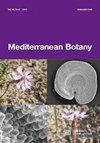Aromatic and medicinal plants used in traditional medicine in the region of Tiaret, North West of Algeria
IF 0.7
4区 生物学
Q3 PLANT SCIENCES
引用次数: 7
Abstract
Herbal medicine is gaining an increasing importance in the management of various ailments, but little is known about traditional practices in Algeria. This ethnopharmacological study aims to document medicinal and aromatic plants used in traditional medicine in the region of Tiaret (northwest of Algeria) in order to contribute to safeguard the local pharmacopoeia as cultural heritage, and to provide a scientific basis for developing novel strategies for such practices which can help for drugs discovery. Semi-structured interviews with 64 traditional healers and herbalists were realized in the region of Tiaret (Algeria) throughout field studies achieved from December 2018 to May 2020. Interviews covered sociodemographic information, popular and vernacular names of the medicinal plants, mode of use and toxicity among other data. Results reveal the use of 107 plant species belonging to 45 families and 97 genera for the treatment of various ailments. Lamiaceae, Apiaceae and Asteraceae were the most represented families. The most frequently cited species were Senna alexandrina Mill. (FC=27), Atriplex halimus L. and Bunium incrassatum Amo (FC=23 each), Foeniculum vulgare Mill. (FC=22), and Matricaria chamomilla L. (FC=21). However, the higher use values were reported for Nigella sativa L. (UV=1.5), Trigonella foenum-graecum L. (UV=1.38), Thymus serpyllum L. (UV=1.2), Ziziphus lotus (L.) Lam. (UV=1.14), Urtica dioica L. (1.13), and Senna alexandrina Mill. (UV=0.52) respectively. Interestingly, Bunium incrassatum Amo, Echinops spinosissimus Turra, Cucurbita moschata Duchesne, Pennisetum glaucum (L.) R.Br and Malus domestica Borkh. were reported for the first time as medicinal plants in the north Africa and Algeria. Moreover, 246 new therapeutic uses were described. It should be noted that Pistacia atlantica Desf., Tetraclinis articulata (Vahl) Mast., Oudneya africana R. Br., Euphorbia guyoniana Boiss. & Reut, Teucrium polium L. and Marrubium deserti (Noë) Coss. are endemic to North Africa-Algeria, Northern and Central Sahara. Furthermore, Artemisia herba-alba Asso, Anacyclus pyrethrum (L.) Lag., Cuminum cyminum L., Saussurea costus (Falc.) Lipsch., Boswellia sacra Flueck. and Pistacia atlantica Desf. are considered threatened, rare or endangered species. Our findings are relevant not only for the future studies and experiments in the search for novel compounds, but also for the safeguard of traditional knowledge and biodiversity.阿尔及利亚西北部Tiaret地区传统医学中使用的芳香和药用植物
草药在治疗各种疾病方面越来越重要,但人们对阿尔及利亚的传统做法知之甚少。这项民族药理学研究旨在记录Tiaret地区(阿尔及利亚西北部)传统医学中使用的药用和芳香植物,以保护当地药典作为文化遗产,并为制定有助于药物发现的新策略提供科学依据。在2018年12月至2020年5月期间进行的实地研究中,在Tiaret(阿尔及利亚)地区对64名传统治疗师和草药医师进行了半结构化访谈。访谈内容包括社会人口统计信息、药用植物的流行和方言名称、使用方式和毒性等数据。结果表明,我国利用45科97属107种植物治疗各种疾病。Lamiaceae、Apiaceae和Asteraceae是最具代表性的科。被引频次最高的种是山仙子。(FC=27),海凤头草(triplex halimus L.)和长叶凤头草(buunium inassatum Amo) (FC=23),普通小叶草(Foeniculum vulgare Mill)。(FC=22)和洋甘菊(FC=21)。其中,利用价值较高的品种为黑草(Nigella sativa L.) (UV=1.5)、葫芦巴(Trigonella foenum-graecum L.) (UV=1.38)、百里草(thyymus serpyllum L.) (UV=1.2)、荷花(Ziziphus lotus L.)。林。(UV=1.14)、荨麻(utica dioica L.)(1.13)和山塞纳(Senna alexandrina Mill)。分别(紫外线= 0.52)。有趣的是,锦葵,棘棘棘,葫芦,青花草(L.)R.Br和海棠。在北非和阿尔及利亚首次作为药用植物报道。此外,还描述了246种新的治疗用途。值得注意的是,大西洋黄连木。,关节四线菌(Vahl)桅杆;[au:] [au:]大戟属植物。& Reut, Teucrium polium L.和Marrubium deserti (Noë) Coss。是北非-阿尔及利亚、撒哈拉北部和中部的特有种。此外,黄花蒿、除虫菊无环虫(L.)滞后。,茴香,雪莲(Falc.)Lipsch。Boswellia sacra Flueck。和大西洋黄连木。被认为是受威胁、稀有或濒危物种。我们的发现不仅对未来寻找新化合物的研究和实验具有重要意义,而且对保护传统知识和生物多样性也具有重要意义。
本文章由计算机程序翻译,如有差异,请以英文原文为准。
求助全文
约1分钟内获得全文
求助全文
来源期刊

Mediterranean Botany
Agricultural and Biological Sciences-Plant Science
CiteScore
2.40
自引率
10.00%
发文量
30
审稿时长
12 weeks
期刊介绍:
Mediterranean Botany (ISSNe 2603-9109), formerly Lazaroa, is a biannual journal that publishes original research studies in the field of Botany including plant systematics, vegetation ecology, biogeography, evolutionary biology, ecophysiology, community ecology, ethnobotany and conservation biology on Mediterranean biomes but also in interacting areas.
Mediterranean Botany is an OPEN ACCESS Journal, free of charges for any published article.
 求助内容:
求助内容: 应助结果提醒方式:
应助结果提醒方式:


